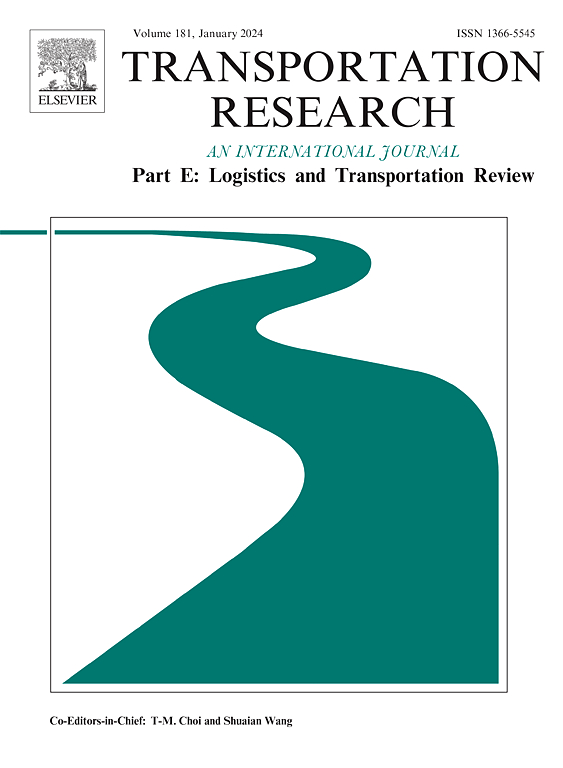Recycling ships, revitalising ports: Assessing the economic viability of diversifying coal ports with ship recycling
IF 8.3
1区 工程技术
Q1 ECONOMICS
Transportation Research Part E-Logistics and Transportation Review
Pub Date : 2025-05-21
DOI:10.1016/j.tre.2025.104212
引用次数: 0
Abstract
The global ship recycling industry, dominated by South Asia, faces increasing scrutiny over environmental and safety practices. Simultaneously, a growing move away from coal in the run-up to 2050 will threaten coal ports, challenging them to diversify. This study explores the potential of embedding ship recycling into the transport geography of coal ports that are diversifying to circular economy hubs. We examine a case study of the Port of Newcastle in Australia, currently the ‘world’s largest coal port’. Using a System Dynamics (SD) model, the study evaluates key factors including global demand, operational costs, carbon credits, and recycled material revenues across four scenarios. The base scenario shows the PON facility is unviable at a break-even price of $540 per LDT compared to South Asia’s $780 per LDT. However, profitability improves when key factors such as carbon credits and recycled steel prices are optimised, highlighting the potential for economic viability with targeted policy and market reforms. Further Monte Carlo analysis reveals a wide range of potential profit outcomes, from $-1,284,205 to $1,077,655, reflecting the financial uncertainties and risks associated with the facility. Overall, the study recommends reforms to stabilise the Australian Carbon Credit Unit (ACCU) market, develop a green steel industry, and promote sustainable ship design. With these measures, the proposed ship recycling facility at the PON would be profitable, economically sustainable, and well-positioned to compete globally, paving the way for a shift in the geography of ship recycling from unsustainable facilities in South Asia to developed countries with higher environmental and safety standards. This transition would support Australia’s circular economy aspirations, foster global best practices in sustainable ship recycling, and contribute to achieving its environmental goals.
回收船舶,振兴港口:评估利用船舶回收实现煤炭港口多样化的经济可行性
以南亚为主导的全球船舶回收业在环境和安全方面面临越来越多的审查。与此同时,到2050年,越来越多的人不再使用煤炭,这将威胁到煤炭港口,挑战它们实现多样化。本研究探讨了将船舶回收纳入煤炭港口运输地理的潜力,这些港口正在向循环经济中心多元化。我们研究了澳大利亚纽卡斯尔港的一个案例研究,该港口目前是“世界上最大的煤炭港口”。该研究使用系统动力学(SD)模型,评估了四种情况下的关键因素,包括全球需求、运营成本、碳信用额度和回收材料收入。基本方案显示,PON设施在每LDT 540美元的盈亏平衡价格下是不可行的,而南亚的每LDT 780美元。然而,当碳信用额度和再生钢铁价格等关键因素得到优化时,盈利能力就会提高,这突显了通过有针对性的政策和市场改革实现经济可行性的潜力。进一步的蒙特卡罗分析揭示了广泛的潜在利润结果,从-1,284,205美元到1,077,655美元,反映了与该设施相关的财务不确定性和风险。总体而言,该研究建议进行改革,以稳定澳大利亚碳信用单位(ACCU)市场,发展绿色钢铁工业,并促进可持续船舶设计。有了这些措施,PON拟议的船舶回收设施将是有利可图的,经济上可持续的,并处于全球竞争的有利地位,为船舶回收从南亚不可持续的设施转移到具有更高环境和安全标准的发达国家铺平道路。这一转变将支持澳大利亚的循环经济愿望,促进可持续船舶回收的全球最佳实践,并有助于实现其环境目标。
本文章由计算机程序翻译,如有差异,请以英文原文为准。
求助全文
约1分钟内获得全文
求助全文
来源期刊
CiteScore
16.20
自引率
16.00%
发文量
285
审稿时长
62 days
期刊介绍:
Transportation Research Part E: Logistics and Transportation Review is a reputable journal that publishes high-quality articles covering a wide range of topics in the field of logistics and transportation research. The journal welcomes submissions on various subjects, including transport economics, transport infrastructure and investment appraisal, evaluation of public policies related to transportation, empirical and analytical studies of logistics management practices and performance, logistics and operations models, and logistics and supply chain management.
Part E aims to provide informative and well-researched articles that contribute to the understanding and advancement of the field. The content of the journal is complementary to other prestigious journals in transportation research, such as Transportation Research Part A: Policy and Practice, Part B: Methodological, Part C: Emerging Technologies, Part D: Transport and Environment, and Part F: Traffic Psychology and Behaviour. Together, these journals form a comprehensive and cohesive reference for current research in transportation science.

 求助内容:
求助内容: 应助结果提醒方式:
应助结果提醒方式:


